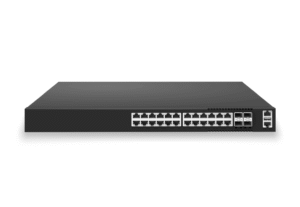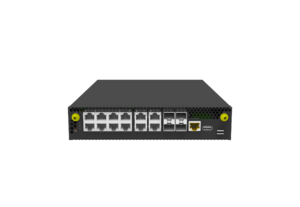Case Study (I): Asterfusion’s Open Campus Network Solution at Bohai University of Technology
written by Asterfuison
Project Background
Bohai University of Technology, located in China, spans 800 acres with a building area of 131,700 square meters, and serves over 13,000 faculty and students, connecting more than 30,000 devices. With the continued growth of teaching and research activities, the university faced increasing network traffic and device access demands. Therefore, there was an urgent need to upgrade the existing network infrastructure to ensure it could support future requirements.

Challenges and Requirements
Given the large-scale nature of the university’s network, the original architecture could no longer meet the need for efficiency, stability, and scalability. The university required a low-latency, high-performance network design to support the connection of a large number of devices while ensuring seamless roaming and efficient management. In addition, the campus network needs to have unified traffic collection and monitoring capabilities, as well as a centralized controller to help maintenance personnel simplify their operational tasks.

Asterfusion Open Campus Network Solution
To meet the needs of Bohai University of Technology, we designed and implemented an efficient, flexible network architecture solution, which includes the following key elements:
Network Architecture Design:
We adopted multi-homing architecture and divided the network into five Pods, interlinked by two CX532P-M-H Super Spine switches. This design improved network scalability, fault tolerance, and performance.

Device Configuration:
- 637 units APs – AP6030 deployed
- 48 units of CX204Y-24GT-SPW2 Leaf switches configured
- 10 units of CX308P-48Y-M-H Spine switches deployed
- 2 units of CX532P-M-H Super Spine switches aggregated the 5 Pods, forming an efficient Leaf-Spine architecture.
Exit Design:
- The Marvell Octeon 10-series Asterfusion ET2500 Smart Gateway was used. It provides 48 Gbps forwarding and routing performance and supports up to 2 million routes.
- The Asterfusion CX202P-24Y-M-H Border Leaf switches ensured the efficient and secure forwarding of network traffic, supporting routing, load balancing, and traffic management functions.
Traffic Collection and Analysis.
- Traffic mirroring and filtering were implemented on the Super Spine switches -Asterfsuion CX532P-M-H, and then, traffic was transmitted to the ET3212A for analysis.
- The Asterfusion ET3212A was used to run Ntopng and our advancing packet broker software, FusionNOS, for comprehensive traffic collection and analysis, enabling full network traffic visibility.
- The CX-M SONiC-based campus switches leverage the power of SONiC’s containerized open architecture, seamlessly integrating the Packet Broker function into a single container. This innovative design supports a range of advanced features, including traffic mirroring, raw data tagging, filtering, aggregation, preprocessing, load balancing, and output replication. By combining traditional switching and Packet Broker tasks in one platform, these SONiC cloud switches not only reduce costs but also significantly boost network efficiency, offering a smarter, more streamlined solution for modern campus networks.
Unified Management via OpenWiFi Controller:
The Asterfusion OpenWiFi Compatible Controller revolutionizes network management by seamlessly unifying the monitoring and control of 637 APs and hundreds of SONiC cloud switches. This powerful solution streamlines maintenance tasks, ensuring effortless operations while providing unmatched flexibility and ease of management. As a result, it significantly enhances network maintainability and efficiency, giving your team more time to focus on strategic initiatives rather than routine upkeep.
Wi-Fi Roaming Latency Improvement:
The innovative Anycast Gateway technology was introduced to forward traffic directly to upstream Leaf switches, avoiding traditional routing issues in roaming scenarios. This significantly improved network efficiency. The Anycast Gateway configuration ensured that users did not need to re-authenticate during roaming, and their IP addresses remained unchanged. Through the BGP-EVPN protocol, ARP table sharing was enabled between the Leaf and Spine switches, ensuring smooth routing and synchronization of client data. Wi-Fi switching latency was reduced to approximately 10 milliseconds, ensuring a seamless and high-speed roaming experience across the campus network.

IP Routing Planning and Optimization:

We implemented a three-tier network architecture and utilized IP routing aggregation technology, which significantly optimized the management of MAC addresses and routing tables. The Super Spine and Spine switches only stored MAC addresses of remote physical devices, reducing the size of the MAC address table and saving network resources.
MAC Address Table and Routing Table Management:
The MAC address tables on the Leaf switches were locally managed. Each Leaf switch connected to around 20 APs, and each AP supported up to 100 dynamic terminal devices, leading to an average of 2,000 MAC addresses per Leaf switch. On the AP side, each AP is connected to up to 100 terminals, resulting in approximately 100 MAC addresses per AP. With routing aggregation technology, the routing tables and MAC address tables on the Leaf switches were synchronized and locally stored, simplifying network configuration and management.
IPv6 Support and Address Planning:
In the IPv6 environment, each MAC address corresponded to one IPv4 address and two IPv6 addresses. Based on this design, the Leaf switches were capable of supporting around 2,000 IPv4 addresses and 4,000 IPv6 addresses. This optimization ensured efficient network traffic management even during large-scale terminal device access, guaranteeing network performance and stability.
Network Aggregation and Traffic Management:
When traffic aggregated to the Spine switches, all host routing information was centrally managed, ensuring network efficiency. The entire network design supported up to 30,000 MAC addresses and 60,000 IPv6 host routes, with robust scalability and stability to accommodate future network growth.
Implementation Results
The optimization of the network architecture led to significant improvements in the performance of Bohai University of Technology’s network, including the following results:
- Increased Network Stability: The optimized network architecture supported stable device connections, efficiently distributed traffic, and improved overall network stability.
- Enhanced Scalability and Flexibility: The Pod design and Super Spine switches enabled the network to easily accommodate future expansion needs, reducing the frequency of hardware upgrades.
- Reduced Maintenance Costs: Unified management through the OpenWiFi Controller simplified maintenance tasks, reduced manual intervention, and lowered operational complexity, significantly reducing maintenance costs.
- Lower Total Cost of Ownership (TCO): By utilizing the traffic mirroring and filtering functionality of the SONiC-based Super Spine switches, there was no need for additional visualization switches. Integrated traffic collection and analysis reduced extra expenditures and improved network management efficiency.
- Improved User Experience: The reduced Wi-Fi roaming latency ensured a smooth experience for faculty and students in online teaching, research, and daily operations.
Customer Feedback
“We are grateful to the Asterfusion team for providing us with a comprehensive solution. The new network architecture has not only significantly improved system stability and performance but also simplified expansion and maintenance. We look forward to further cooperation with Asterfusion to drive technological development.”
— Head of Network Management Department, Bohai University of Technology
Conclusion
The network architecture optimization project at Bohai University of Technology demonstrates our technological innovation and practicality. By adopting a Leaf-Spine architecture combined with traffic collection, monitoring, and unified management, the university’s network achieved significant improvements in performance, stability, scalability, and maintenance management. The project also helped the client lower TCO, avoiding the additional purchase of visualization switches, and enhanced network efficiency. This case study highlights our strengths in providing customized, high-performance network solutions for large educational institutions and showcases our technical expertise and industry experience.










